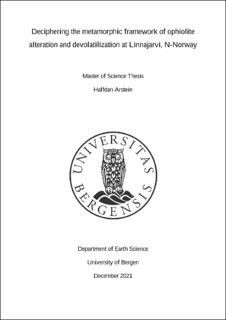Deciphering the metamorphic framework of ophiolite alteration and devolatilization at Linnajarvi, N-Norway
Master thesis
Permanent lenke
https://hdl.handle.net/11250/2838808Utgivelsesdato
2021-12-01Metadata
Vis full innførselSamlinger
- Department of Earth Science [1096]
Sammendrag
Kvitfjell ultramafic body is one of around 20 ultramafic bodies found in the Linnajavri area of Northern Norway. These ultramafic fragments are situated within the Köli Nappe of the Upper Allochthon in the Caledonian tectonostratigraphy. At Kvitfjell ultramafic body, secondary metamorphic olivine is observed, formed by a reaction of magnesite and antigorite which releases CO2-bearing fluids. The metasediments adjacent to Kvitfjell ultramafic body suggest that this decarbonation occurred at shallower depths than previously recorded. Peak PT conditions for Kvitfjell ultramafic body, thus peak PT conditions at which decarbonation initiated, are derived from the metasediments surrounding Kvitfjell ultramafic body which is presumed to have gone through the same metamorphic path as the ultramafic body itself. The PT estimate is acquired by conventional thermobarometry, trace element thermometry, image analyses and thermodynamic modelling based on the whole rock chemistry of the adjacent metasediment. PT estimate from garnet-biotite and garnet-biotite-aluminosilicate-quartz geothermobarometry suggest that peak PT conditions are at a temperature of 593°C ±8°C and a pressure of 7.03 kbar ±0.17 kbar. This PT estimate is further supported by pseudosection modelling, observed and modelled mineral abundances, and peak PT estimate from the Ti-in-biotite thermometer coupled with the garnet-biotite-aluminosilicate-quartz barometer. These findings reveal that the decarbonation at Kvitfjell ultramafic body occurred at shallower depths than previously recorded. Transferring the temperature estimate from Kvitfjell ultramafic body to subduction zones implies that the decarbonation processes may initiate at an earlier stage than previously assumed and that carbonates become unstable before reaching sub-arc depths.
